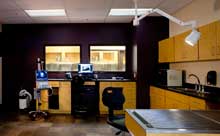Light up your veterinary life
Anyone NOT want cooler surgery lights or better task lighting? Advances in lighting could make these reasonable updates for your veterinary practice.
The lighting aisles have some new options these days, and these new LED bulbs would obviously be happy to get adopted into your practice. On the upside, they last longer. They use less energy. They don't generate heat, so your practice will stay cooler if you make the switch. (Which could save you more energy by reducing your cooling needs in the summer, depending on where you live.)

This ultrasound / endoscopy room at PetCare Veterinary Hospital in Santa Rosa, California, features lighting that dims. (Photo by Tim Murphy, fotoimagery)
On the downside, although they're coming down in price, they're still more expensive than florescent lighting. (Still, you do save money in the long term, because, did we mention, they use less energy.) Also on the maybe-a-minus side, to switch to LED lighting, you also have to change your fixtures. (Why "maybe?" Well… if the previous practice owner installed some now-dated cheapo lights that you hate, NEEDING to replace the fixtures could actually be a plus. And a lighting update can be a manageable time and money investment that makes a big, big difference in your workday.) To give you some financial grounding, new fixtures will cost about $150 to $300 each depending on the fixture and not including labor.
Veterinary architect Heather Lewis says LED lights can offer some great advantages for you and your team, for your clients, and perhaps most important, for your patients.
1. Happier housing. Florescent lights are cheap to buy but expensive if you want to make them dim. LED lights are easy to dim and coming down in price. And lower light can reduce boarders' and patients' stress.
2. See better. Better task lighting in surgery, exam rooms, and at work stations could be just the break your eyes are looking for. And who doesn't want surgery lights that don't make you sweat. More light. Less heat. That's what LED gets you.
3. Cut the noise. If the buzz of your old florescent lights bugs you after hours when machine noise and chatter are at a minimum, chances are it's worrying your patients (with their super hearing) far, far more and all the time. In fact, even if you can't hear it at all, they may. And that can be causing unnecessary stress.
4. Have a little fun. The rules for professional lighting are changing. In the Veterinary Economics Hospital Design Competition, the judges are seeing far more entries with fun bubble light fixtures, chandeliers, and other playful lighting in public spaces.
Heather Lewis, AIA, NCARB, is a partner at Animal Arts, an architecture firm in Boulder, Colorado. She's a lighting geek and a (seriously) devoted advocate of minimizing pets' stress and anxiety during their veterinary visits. She has designed practices and shelters that range in size from 1,200 square feet to 110,000 square feet. During grad school (as a break from “architorture”) she trained miniature horses to pull carts!